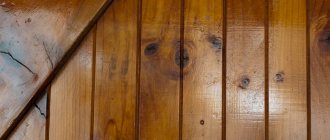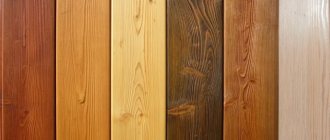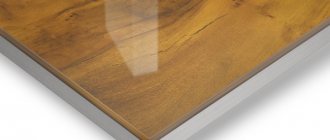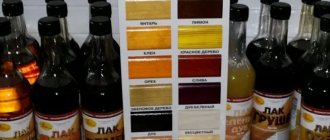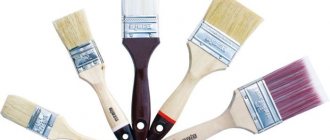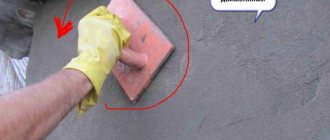Any person sooner or later faces the need for repairs. Today on the construction market there are many tools and materials that will help you update your interior or exterior on your own. One way is to paint interior wooden surfaces - window frames, doors, floors or even walls.
A wooden surface painted with drying oil does not always look attractive
Many people do not approach this issue seriously, so they buy the first available (that is, cheap) paint and start working without first preparing the surface, which becomes the main mistake.
If we are talking about a clumsy process with a roller, the result of which is visible on every fence, then the direction has been chosen correctly. But at the heart of any well-done finishing operation is attention to detail, which should be taken care of in advance. Otherwise, you can not only waste time, effort and money, but also completely ruin the consumables and the wooden object itself.
Therefore, it is important to take into account the nuances. For example, what to do if the wooden surface was previously covered with a coloring or strengthening solution: varnish, paint, impregnation or drying oil? The last composition is more problematic than the others, so, first of all, you need to figure out: with what and how to paint the drying oil previously applied to the surface of the wooden material?
To answer this question, you should get a little closer to such a construction archaism as drying oil, and understand why its use nowadays causes such heated debate, both in the professional community and in amateur circles?
Features and disadvantages of drying oil
Drying oil is a film-forming liquid consisting of sediments of vegetable oil (linseed, hemp, sunflower, mulberry, etc.), which is processed in a special way (overheating or oxidation). And the solvents and driers in its composition are similar to oil paints, varnishes, primers and putties. In other words, drying oil as a finishing mixture can be used as any lubricating or coloring raw material.
Drying oil is both a coloring agent and an impregnating agent.
In the Soviet years, oil paint based on drying oil was almost the only available means of painting surfaces. It was applied to literally everything: floors, walls, ceilings, doors, windows and even furniture. When removing worn-out wallpaper layer by layer, old tiles in the bathroom or worn-out linoleum, there is a high probability that you will come across an oiled surface. Previously, not a single repair could be done without it.
With the appearance of new paint and varnish mixtures on the shelves of construction stores, drying oil began to be used only for putty purposes in order to give integrity to the porous structure of the material and protect it from moisture. Due to its viscous composition, drying oil has good filling properties, which significantly reduces its consumption. Another area of its application is painting metal surfaces and walls and ceilings in service areas (toilet, locker room, industrial kitchen) where there are hoods. In addition, it is used to prime concrete surfaces and renew wood in exterior work.
With all its advantages, drying oil has a number of significant disadvantages, of which those who have at least once tried to apply another paint and varnish substance to it without pre-treatment are well aware. Among the obvious disadvantages it should be noted:
- low adhesion (adhesion) in relation to other paints, so even the most expensive paint will “peel off” after a short time;
- a strong odor that never completely evaporates either during or after the process and creates a stuffy, unpleasant atmosphere in a closed room;
- slow drying, from several hours to a couple of weeks, depending on the type and composition (the fastest is natural, and the longest is synthetic);
- fire and explosion hazard due to the presence of flammable solvents in the composition;
- inconvenient to use, since you need to work with it only in a warm room (over 20 degrees), having warmed the mixture in advance;
- fragility.
Painting with cheap drying oil is not recommended; it has a number of negative qualities
It must be said that all of the above negative aspects are for the most part characteristic of low-quality, cheap drying oil. A good coating only partially has them.
It would seem that it is simply impossible to re-paint a surface impregnated with drying oil. But the situation is not as dire as it seems at first glance. The main thing is to choose the right tools and paint.
What is drying oil - general description
Before dealing directly with Oxol drying oil, it would be correct to consider what drying oil is in general. The most accurate definition is the literal translation of this word from Greek - “boiled butter.”
Drying oil is made from oils that are subjected to heat treatment. As a result, the resulting composition with additives does not absorb moisture and does not dissolve in water, and is able to penetrate deeply into the fibrous base. Therefore, drying oil is most often used for wood and wood boards - after impregnation, the wood will last much longer.
Impregnation is carried out on different bases, which is reflected in its color, which can be yellow, brown or brown. The more layers are applied, the more saturated the shade of the coating will be. Thus, linseed oil is close to transparent, while hemp oil becomes dark.
Oil by its nature tends to thicken, but does not dry out completely. The resulting film remains greasy for a long time. To make the impregnation dry, oils containing linolenic or linoleic acid are used to make drying oil. So, for example, in flaxseed oil their content is 80%, in hemp oil - about 70%, from 30 to 50% is found in nut, sunflower or poppy oils. How long drying oil dries on wood depends on the oil that is included in the impregnation. On average it is 24-30 hours.
Drying oil with sunflower oil Source nashaspravka.ru
Returning to the translation, let’s focus on the “boiled” layer. Without temperature exposure, the process of making drying oil takes several months. To speed up the process, the raw material is brought to a boil. As a result, components decompose, which negatively affect the drying of the film.
With the participation of metal salts, the oxidation reaction occurs and proceeds faster. Thus, the introduction of manganese provokes thickening of the mass within 6-36 hours, depending on the oil used for the production of drying oil.
On a note! Metal salts that can accelerate oxidation reactions are called “driers” (from the Latin “siccativus” - drying).
Application
For some time it was believed that drying oil was a finishing impregnation for wood. All its varieties have the property of deep penetration and moisture resistance. They are intended to protect wood from parasites and rot, metal from corrosion, and mineral base from biological damage (leveling mixtures, chalk and gypsum).
Today there is another solution for what drying oil is used for - it is used as a working base for oil putties and paints. This is due to their similar nature and high adhesion. The composition also helps to reduce the consumption of finishing materials, since the base after treatment has less water absorption.
Primer layer Source tildacdn.com
Operating principle
The thickening process of the impregnation occurs under the influence of oxygen, positive temperatures and light (mainly sunlight). As a result, the thin-layer coating gradually turns into a hard and elastic film.
The content of fatty acids in drying oil determines the drying speed of the coating. The more of these glycerides, the higher the so-called iodine number (the amount of iodine in grams that is added to 100 grams of organic matter). When considering the technical characteristics of drying oil, one always pays attention to this value.
Thus, flaxseed oil has an iodine number of 174-204, hemp oil has up to 167, and olive oil has less than 94. Compositions with a mineral nature do not contain fatty acids, so the polymerization process is not present.
Terms of use
Drying oil is a liquid that thickens over time and has a relatively low consumption. Therefore, leftovers are often stored until next use. The thick mass can be diluted with castor oil, white spirit, turpentine, and organic acids. These products do not affect the quality of impregnation. The dosage, as a rule, looks like this: 1 part solvent, 10 parts drying oil.
Dilution of thick mass Source 5domov.ru
It is important to note the ability of drying oil to burn. Organic solvents also have a similar property. If liquids are handled incorrectly, there is a risk of spontaneous combustion and even explosion.
Drying oil can only be applied to a prepared surface. It should be clean, dry and free of grease stains. You can work with a soft bristle brush or roller. Form 2-3 layers with intermediate drying. The average consumption is 130 ml/sq.m.
See also: Catalog of companies that specialize in paints and finishing materials
Storage conditions
Transportation of finished products is carried out in glass or plastic containers with a sealed lid. These materials do not oxidize and do not allow moisture to pass through with air. This container, like other options, minimizes the process of thickening the contents, but does not completely eliminate it.
Materials that support fire must be stored in ventilated areas. For drying oil, it is important to ensure the absence of sun and moisture. The container must also be airtight and tightly closed.
Packaging for drying oil Source stroimaterials.ru
Choosing paint and tools
When working with oiled material, choosing the right paint is of paramount importance. Anyone who tried to put paint on drying oil invariably noticed: the freshly applied coating “bubbles” as it dries, and the opened bubbles have a yellow, resinous content and a characteristic smell of drying oil.
Still, there are several types of dyes and finishing materials that I can cope with the difficult drying oil. These include:
- Oil paint;
- alkyd paint;
- acrylate oil paint;
- pentaphthalic enamel (or otherwise called PF-115);
- nitrocellulose varnish (or otherwise called NTs-132);
- oil-based liquid wallpaper;
- self-adhesive paper or film.
Pentaphthalic enamel easily copes with drying oil and fits perfectly on top of it.
Any of these options is perfect for painting not only wood, but also concrete and metal surfaces. You should not try to paint drying oil with quick-drying nitro enamel or water-based paint: our cunning oil-based impregnation will simply “repel” the layer of paint. To use water-dispersion and water-based paint, the surface must be thoroughly washed and cleaned, removing the film from the drying oil. In this case, 2-3 layers of water-based paint will cover the surface, but, unlike other compositions, will not saturate it.
Several new devices are purchased for the standard set of tools:
- roller or brush;
- spray gun or spray gun;
- paint mixing tray;
- a bucket of soapy water;
- clean rags;
- a stiff bristle brush or sandpaper;
- metal spatula;
- draw frame or manual scraper;
- disinfectant composition (antiseptic, fire retardant, acetone, xylene, solvent);
- wood putty or concrete plaster;
- primer;
- gloves and respirator.
To apply self-adhesive film you need:
- stationery knife;
- powder or talc;
- water with cleaning solution;
- dry rag;
- pin or needle.
The self-adhesive film looks good and can easily be glued onto surfaces pre-treated with drying oil.
Everything you need is at hand. Nothing prevents you from getting to work.
Surface preparation
The importance of pre-treatment of the oiled surface has been discussed more than once. Only a short-sighted amateur who does not feel sorry for his wasted efforts and money on materials can omit the preparatory stages. A thrifty owner would prefer to do everything once, but thoroughly and well.
So, here is the sequence in which the processing work needs to be carried out:
- Clean surfaces from mechanical contamination: traces of old paint or putty, rust, lime, grease stains, soot and dust. Depending on the type of material (wood, concrete, metal), this should be done using a metal spatula or a brush with stiff bristles. Wash with soapy water. Let it dry.
- Sand or, if possible, plan the top layer (the latter is only for wood), using coarse sandpaper, a hand scraper or, better yet, a belt sander. Wash with water. Let it dry.
- Seal all chips and cracks with plaster or putty. Sand with fine-grit sandpaper. Wipe with a damp cloth.
- Prime. Let it dry. Sand it. Wipe with a damp cloth. Wait until completely dry.
- Apply the disinfectant composition no later than 6 hours after the previous stage. Let it dry.
These carefully completed stages will greatly facilitate the application of paint and prevent their deformation throughout their entire service life.
After surface treatment, the painting process can only bring a good mood
Now that the negative properties of drying oil have been minimized as much as possible, it’s time to begin the procedure of painting or gluing the surface.
Painting work is carried out in several stages at temperatures from –30 to +40 degrees and relative air humidity not higher than 80%:
- To begin with, hard-to-reach places, welds, and end edges are painted with a stripe layer with a brush.
- The painting solution is applied in one layer using vertical movements, direction from left to right or from the wall farthest to the door with a roller, brush or spray (at a distance of 20-30 cm). It is also possible to dip the object into the paint paste. Wait until it completely dries.
- Metal surfaces are painted in 2–3 layers and dry for up to 3 hours; cement-sand, asbestos-cement and concrete surfaces should be painted in 3 layers, and wooden surfaces – 1–2.
- Rinse the dried surface with hot water (without adding soda or detergent) to remove stains. Wipe again before use.
- (let's say oil ones) can be done by placing 2-3 jars of salt water or grated garlic on a plate next to the painted area or indoors.
It is very important to wait until each previous coat of paint is completely dry before applying the next one. The final drying time of the finished coating at a temperature of +20 degrees is at least 24 hours.
You can check whether the surface has dried or not, perhaps using the traditional method - by placing your finger on the area of painting. If necessary, you should wait a longer period.
Transforming an oiled surface is not the easiest task. But with a skillful approach and competent selection of the necessary tools and finishing materials, in just a few days you can revive the interior and give it a new, more attractive look that will delight its diligent owner for a long time.
Is it possible to apply drying oil to varnish, and how can I select the appropriate materials for surface treatment? To create a protective coating, different types of varnishes and drying oils are used. When using them, the properties and characteristics of materials and the possibility of their combination are taken into account.
Varnishes and drying oils belong to the group of film-forming substances used in the form of solutions. The final appearance of the treated surface depends on their type and composition. Varnishing allows you to protect or emphasize the structure of the surface being painted.
After drying, the coatings form a transparent, durable film; varnishes are often used to apply the base layer.
The range of varnish compositions is represented by a variety of types, methods of application and properties. Among them are:
- bitumen varnishes, which are made from special grades of bitumen, form a black film when dry and are resistant to reagents;
- oil compositions are solutions of vegetable oils with synthetic or natural resins; when dry they give a transparent yellow film;
- alcohol-based ones have a high drying rate and are produced by dissolving natural resins in alcohol;
- alkyd solutions - materials based on synthetic resins and are water resistant;
- alkyd-urea varnishes are used with hardeners and form a hard coating when dry;
- Cellulose nitrate materials are used to apply a protective coating to wood products;
- polyester;
- polyurethane coating materials;
- epoxy and petroleum polymer varnishes.
Drying oil for wood varies in composition, which determines the specifics of its use for impregnation and priming. Natural drying oil is made from plant components of flax, hemp, sunflower with the use of special additives.
Use as a primer helps to emphasize the beauty of the texture, the wood shows its pattern. Solvents are added to its composition to increase viscosity, and to improve the quality of the oil, it is oxidized and heated at high temperatures. They contain only 5% of a special drying additive that accelerates drying. Oxol consists of an oil component, a solvent and a drier. Thanks to this connection, it dries faster and its cost is low.
Composite synthetic material is produced from by-products of the oil refining industry. This type of product is not universal due to low quality. It is not recommended for treating interior spaces.
Compositions based on alkyd resins are of the highest quality. They are used for exterior and interior decoration.
Recommendations for coloring
Now that the negative properties of drying oil have been minimized as much as possible, it’s time to begin the procedure of painting or gluing the surface.
Painting work is carried out in several stages at temperatures from –30 to +40 degrees and relative air humidity not higher than 80%:
- To begin with, hard-to-reach places, welds, and end edges are painted with a stripe layer with a brush.
- The painting solution is applied in one layer using vertical movements, direction from left to right or from the wall farthest to the door with a roller, brush or spray (at a distance of 20-30 cm). It is also possible to dip the object into the paint paste. Wait until it completely dries.
- Metal surfaces are painted in 2–3 layers and dry for up to 3 hours; cement-sand, asbestos-cement and concrete surfaces should be painted in 3 layers, and wooden surfaces – 1–2.
- Rinse the dried surface with hot water (without adding soda or detergent) to remove stains. Wipe again before use.
- You can get rid of the persistent smell of some types of paints (for example, oil paints) by placing 2-3 jars of salt water or grated garlic on a plate next to the painted area or in the room.
It is very important to wait until each previous coat of paint is completely dry before applying the next one. The final drying time of the finished coating at a temperature of +20 degrees is at least 24 hours.
You can check whether the surface has dried or not, perhaps using the traditional method - by placing your finger on the area of painting. If necessary, you should wait a longer period.
Transforming an oiled surface is not the easiest task. But with a skillful approach and competent selection of the necessary tools and finishing materials, in just a few days you can revive the interior and give it a new, more attractive look that will delight its diligent owner for a long time.
]]>
Coating compatibility
As a finishing mixture, drying oil can be used as a component for making putty and for painting metal surfaces. Disadvantages of this mixture:
- low adhesion in relation to other surface coating agents;
- strong persistent odor;
- special working conditions (presence of high temperature in the room);
- fragility;
- long drying time.
In the case of repair work, it must be taken into account that if varnish is applied to a fresh layer of tumbled surface, bubbles will form as it dries.
If you treat wood with drying oil, you can create not only a protective layer, but also a primer layer for the main coat of tinting or clear varnish.
The product is used as a primer and impregnation of the material before painting.
Drying oil is an alternative to others used to impregnate wood. It is worth remembering that not all types can be used for work in residential premises. Guaranteed protection against external factors is achieved when combined with other means.
Some types of paints and nitrocellulose varnish of the NTs-132 brand do not conflict with drying oil. If you try to apply a coating of other materials to drying oil, repulsion will occur.
- using tools, clean the surface from dirt;
- wash with soapy water;
- Use sandpaper to polish;
- seal cracks and sand the surface;
- apply primer.
A layer of varnish can be applied to the drying oil only after final drying. To make the coating stable, you need to use glyphthal, pentafle, and oil varnishes. Use a brush, spray or roller. The choice of materials depends on the type of work performed. In order to cover the surface with a protective layer, you need to choose the right composition for application.
A careful study of product compatibility will help you choose the best painting option. If several types of materials are used, it is better to choose them from one manufacturer. This will avoid conflict when working with them.
Parquet varnish is well suited for the floor; it has the required fluidity on wood and, when dried, forms a transparent film. It can be diluted with white spirit for uniform distribution over the surface. Drying oil consists of components of vegetable and synthetic fats. Applying it to a varnished surface will not produce results.
When working with wood and many other porous surfaces, one of the most commonly used materials is drying oil. We apply it as a primer or for other reasons. But those of you who have come across this product at least a few times know that it has a long drying time, and that work cannot be continued until this drying is complete.
The basis for the olive is overheated and specially oxidized vegetable oil. At the same time, various driers, solvents and other components characteristic of paint and varnish products are added there.
The main task of drying oil is to form a protective layer on the surface of the wood to prevent the penetration of moisture, mold, mildew, rot and insects. Finally, this material is used as a primer, allowing the paint to go on more smoothly and efficiently, and also reducing the consumption of this paint itself.
Do not forget that wood coated with linseed oil is very beautiful, so this paint coating is also used for decorative purposes.
Types of drying oil
The drying time of drying oil on a wooden surface or chipboard depends on the type of product. There are four options on the market today:
- Natural;
- Semi-natural;
- Synthetic;
- Combined.
Natural drying oil, unlike its synthetic “brothers,” is not a fire hazard, since it contains almost no solvents. However, the drying time depends on the type of oil. The product dries on linseed and hemp oil for 24 hours, but sunflower oil will still be sticky at this point
Semi-natural drying oil contains approximately 45 percent solvents. Like natural, it is used not only for coating wood, but also for diluting paint and varnish products. However, the semi-natural option is not used for flooring. Drying time is approximately 24 hours.
Synthetic drying oil is the cheapest. It is obtained by oxidizing shale oil followed by dissolution in xyol. Unlike all the others, it is not used for treating household surfaces. Requires room ventilation. Its scope of application includes priming concrete, metal, diluting paint and varnish products, preparing plaster and mastic. Drying time is usually more than 24 hours
The combined drying oil dries in about a day. It is obtained by polymerization and dehydration of oils. It is not used for coating surfaces - it is used in paint production.
Selection of drying oil
How to choose drying oil correctly? You cannot be guided only by the rule that the higher the level of naturalness, the better. There are the following types of drying oil:
- Natural - the higher the percentage of natural substances in the composition, the higher the cost of the material and its quality. If a product with a 45% composition of vegetable oils can be used for exterior painting, then drying oil with an oil content of 70% or higher can be used for interior work. In any case, the impregnated surface will be protected.
- Combined – material as close as possible to the source material. Its composition, as a rule, contains a mixture of a natural base and white spirit (solvent), which occupies 1/3 of the drying oil structure. This complex is used for external use - the effect of the solvent on the body is practically not noticeable, and drying is faster.
- Drying oil "Oxol" is a middle class product. The impregnation is made from 55% natural oils and is used both indoors and outdoors. Oxol is an excellent assistant in sanding small parts.
- Composite is the cheapest impregnation option. It consists of almost 100% synthetic substances and has a strong, pronounced odor. The use of drying oil on floors and other wooden surfaces in residential premises, no matter how ventilated they may be, is strictly prohibited.
Containing oil, drying oil will be an excellent base for paint. And we are not talking about applying a layer of paint to a dried layer of drying oil. Drying oil-based paint - combines the properties of both substances and does not require varnish.
MA-25 is the name of the paint for treating external surfaces, which is made from combined drying oil.
On video: how to prepare natural drying oil yourself.
How to speed up the drying process of drying oil on a wooden surface or chipboard
Unlike paint, which dries after the solvent evaporates, drying oil dries through the process of oxidation, that is, by contacting oxygen.
Many people ask what to do if the drying oil does not dry out. In reality, you almost always have to wait, and there aren't many ways to speed up the process. One of them is to use a heat gun. The thing is that the drying process of drying oil accelerates under conditions of high temperature and low humidity. And the fan heater does this job very well. By the way, previously it was practiced to apply drying oil hot just to increase the drying speed.
Another way is to use a drier. Red lead is ideal. Please read the instructions carefully before use.
How to tell if drying oil is completely dry and what to do if it doesn’t dry
The main sign that this material is completely dry is the absence of stickiness. However, in some cases, drying oil does not dry out even after 10 days. Most likely the reason is marriage. There is no point in waiting for such drying oil to dry out - it is better to clean it from the surface. One way to do this is with white spirit. However, if the material is deeply embedded in the wood, a plane may be required.
It is no secret that wooden surfaces treated with varnish or paint have a significant disadvantage - they become cold and lifeless. If you intend to preserve the beauty of texture, warmth and energy, we recommend that you pay attention to such a material for wood processing as drying oil.
Manufacturers of drying oil Oxol
Good drying oil is not sold everywhere and not under every brand. Only a few reliable manufacturers can boast of high technical characteristics.
- " Isolate" is a manufacturer known for its quality. Manufactures Oxol drying oil according to standards. Sells products in volumes of 0.5-200 liters. However, it is difficult to find in the market. Most often, the company's products are produced to order, in large quantities.
- "VESTA-COLOR" is also a well-known manufacturer. The drying oil of this brand is high quality. Can be produced in large and small batches, different volumes and to order. The price is reasonable, the technical characteristics are good.
- "Tex" - produces Oxol drying oil according to the standards specified in GOST 190 78. The raw materials are bottled into cans weighing 0.4-8 kg. The composition dries quickly after application, reduces paint consumption, and can be used as a primer.
- KHIMTEK makes good quality drying oil. The products have an affordable price and are available in different containers and different volumes.
- "Yamshchik" mostly produces drying oil Oxol PV in volumes of 0.8-20 kg. The composition complies with GOST standards and is available for sale at a low price.
Drying oil Oxol allows you to protect wood from rotting and beetles, improve the application of the finishing coating on putty or increase the amount of paint in the can. It is convenient and profitable to use and therefore is valued by builders around the world. It is recommended to purchase it in specialized stores, paying attention to the manufacturer. After all, only good companies, known for their reliability, can provide a quality guarantee.
Processing wood with natural drying oil - application features
Most often, flaxseed, hemp and sunflower drying oils are found on the market. Natural linseed oil has a light transparent color. It is used for priming wooden, plastered and metal surfaces, as well as in the preparation of wood putties, pastes and for diluting light paints. The use of natural compounds is allowed indoors. How long does it take for natural drying oil to dry on wood? At a temperature of at least 20 °C – about 24 hours.
Hemp drying oil has a pronounced dark color. The scope of application of the composition is the same as that of flax. But this liquid is used for diluting dark, thickly grated paints. Compared to previous representatives of the group, sunflower impregnation dries more slowly - after a day, undried liquid will still be felt on the surface. Its peculiarity is high elasticity, but in terms of hardness, strength and water resistance it is inferior to hemp and linseed oil.
Natural compounds are excellent for treating wooden surfaces of various instruments. Hunters love to soak gun stocks with them - after this the product lies very softly and warmly in the hand, it is pleasant to touch it with your cheek. However, this group is not suitable for impregnating floor coverings, since the film created by natural compounds does not have high strength.
Drying oils
All manufacturers of this material have generally the same production technology - vegetable oil is subjected to heat treatment and, after a certain filtration, it is mixed with driers. Driers are special metal compounds that accelerate the polymerization process of the oil film. Strontium, cobalt, lithium, lead, iron and manganese - the names of these metals already raise doubts about the safety of the produced compounds.
Therefore, when choosing this composition, be sure to look for all the information on the label about what kind of drier was used - cobalt drier can be considered safe. According to technical requirements and GOST standards, this drier should be from 3 to 5%. If this figure increases, this can lead to accelerated polymerization of the drying oil, and even after coating and drying, this process does not stop, and this can lead to darkening and cracking of the coating in the future. Therefore, at present, all specialists use oils without additives or drier impurities.
If you wish, you can purchase formulations with a minimum content of driers. And such a composition will perfectly protect against moisture. Standard drying oils with drying agent harden within 24 hours, but in hot and windy weather the process can be reduced to 12 hours. Oil compositions that do not have driers added harden within 5 days.
And if you decide to dissolve oil paint with this composition, its drying time will also increase.
With such a long polymerization process, the oil component penetrates deep into the wood fibers, and the wood in the future better repels moisture and resists various fungi and mold.
When mixed with siccating additives, the oils do not penetrate as deeply. The film that forms on the wood can crack or peel off over time.
The rate of natural polymerization of vegetable oils will depend not only on the production speed, but also on the amount of polyunsaturated fatty acid glycerides.
The highest glyceride content is in flaxseed and hemp oil, about 80%. Sunflower oil, which is used for cheap drying oils, contains only 30% glycerides and, even in the presence of drier, dries several times slower. Castor oil does not thicken over time and does not harden, and olive oil is practically not subject to the hardening process.
According to the relevant GOST, natural drying oil should contain 97% vegetable oil and only 3% impurities.
Although, many manufacturers often violate this rule, trying to increase the hardening speed. You can easily determine the percentage of impurities when purchasing drying oil; if the solution, according to the manufacturer, hardens within 24 hours, then in this composition the amount of driers exceeds 3%. And from a safety point of view, this solution will be more harmful than linseed oil, which hardens over a similar period of time.
During the production process, all vegetable oils and paints based on them undergo a simmering process at elevated temperatures, heating occurs at about 300C, and holding time is about 12 hours.
Further, the technology may vary; drying oil after heat treatment without special air purging is called standard. And drying oil that has undergone the blowing process is called oxidized or oxidized. Natural drying oil has a sweet aroma of vegetable oil, its color is usually light brown or dark brown, and it usually takes a long time to dry.
Semi-natural, combined, synthetic – areas of application of drying oils
Semi-natural drying oils are generally light brown in color. The resulting film on a wooden surface is characterized by hardness and good gloss, as well as fairly high water resistance. Basically, semi-natural compositions are used in combination with other paints and varnishes or as a primer. Like natural drying oils, semi-natural ones do not have sufficient strength for processing floor coverings.
Manufacturers add modifiers to combined compositions that improve their qualities necessary for the production and dilution of thick paints. Combined drying oils are also used for priming wooden surfaces before plastering or painting.
Do not forget that the liquid dries for at least a day - it is not recommended to apply a layer of paint or plaster until completely dry.
Synthetic compositions are used not so much for impregnation, but as a basis for diluting dark oil paints for exterior painting, as well as for priming metal, concrete and plastered surfaces. Synthetic drying oil is also used to prepare all kinds of putties and pastes.


